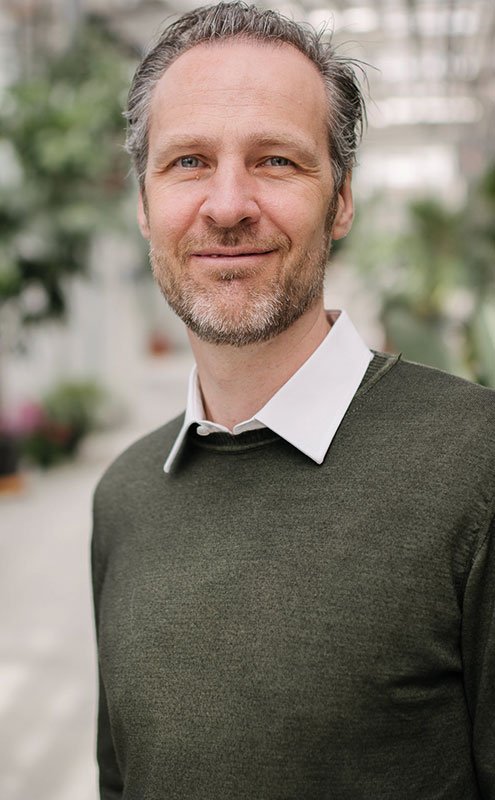 Download this article in magazine layout
Download this article in magazine layout
- Share this article
- Subscribe to our newsletter
"If we only rely on safe bets, we will miss out on big opportunities"
Rural 21: Mr Mittmann, how did the Saving Grains idea evolve?
Wolfgang Mittmann: My work for the World Food Programme above all focused on smallholders and the grain trade. Here, I encountered the same structural problems again and again – problems which make it impossible for smallholders to get out of the poverty trap. While these problems may indeed be huge, some are also very easy to solve.
What are the problems?
Mittmann: Smallholders in sub-Saharan Africa, but also in South Asia and in many other countries, can’t produce cheaply. While total production is limited by the small plot size, such tiny plots don’t allow realising economies of scale. Let’s take mechanisation, for example. It’s often more expensive to take the tractor to the field than to plough the field by hand. This results in high prices. In Ghana, for instance, buying grain on the world market is cheaper than producing it at home.
Even so, most African countries are seeking food sovereignty …
Mittmann: This is a political and also sensible goal which development cooperation rightly supports. But achieving it requires structural transformation, which is associated with many politically sensitive topics, such as land reforms and subsidies, and therefore isn’t easy to implement. And then there are dilemmas regarding its objective. While farmers are supposed to raise their production, mistakes which we have made in agriculture in the Global North, such as applying excessive levels of agro-chemicals, with their negative impacts on the environment and biodiversity, are to be avoided. And although there are many good and successful projects in this area, one has to concede that progress made over the last ten years hasn’t exactly been gigantic.
What is your company doing differently?
Mittmann: We did not come from the production, yield and cost angle but looked at profits. The smallholder margin, in other words the sales price minus costs, is at a rough average around 15 per cent in Ghana. It’s much lower in Kenya, where farmers produce their grain almost at cost.
Why is this the case?
Mittmann: Farmers sell at low prices during the harvest. Over the year, grain prices aren’t really so low, but there are considerable seasonal dynamics. And whereas price fluctuations in Germany, for example, hover around two per cent, we’re talking about roughly 80 per cent in Ghana, and in Kenya, which has two growing seasons, prices move between 50 and 90 per cent. Farmers sell during the harvest season, causing an immense oversupply which forces the price down towards the production price. This applies especially to commodities like maize and beans. Later, prices rise gradually again, and selling would become worthwhile, only that at this stage, the farmers usually no longer have any maize.
Because they lack storage facilities?
Mittmann: Yes, that’s one of the reasons. If grain is stored in normal bags, which is the usual way of storing in the countries we’re looking at, it is often eaten up by storage pests. Moulds producing aflatoxins are a further issue. In many African countries, this is a huge public health problem which contributes to high liver cancer rates and stunting among children. So with traditional storage, after a certain time, the farmer has less grain – weight loss being at around 25 per cent – which is of poorer quality as well. Therefore, since farmers are eager to sell good grain, they don’t want to store grain for a longer period.
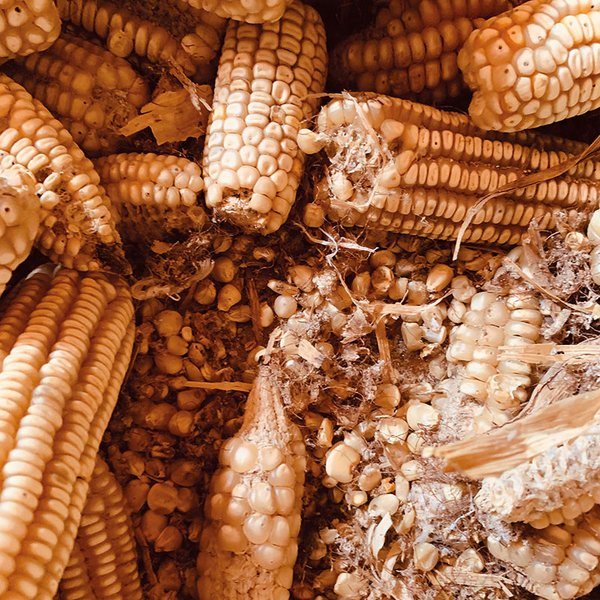
Insect damage in maize results in quality and quantity losses.
However, a further factor is often forgotten. Farmers need money. The harvest is needed, for instance, to pay back formal or informal agricultural loans and services provided on credit. Other costs are also incurred, such as school fees. Farmers are expected to have money at the time of the harvest, which also makes sense from the point of view of service providers. So farmers have to sell at least part of their harvest.
How does Saving Grains intend to solve these problems?
Mittmann: We buy up the farmers’ harvest at the time of the harvest and store it in safe, hermetic bags in community warehouses, so that the quality is maintained. We subsequently arrange off-take with industrial buyers at a point in time when prices are high. Farmers then get a kickback, a 10-20 per cent share of the profit. So we offer them a service via which they obtain part of the grain’s future price. Should prices go up less than usual, or even fall, then there is little or no profit share – but neither is there any risk. This is of course a very popular model. Which farmer wouldn’t be happy to sell his grain without any market risk and, six months later, get money again, just like that? And since the structural problems in most SSA countries are very similar, the model can be scaled.
That sounds straightforward …
Mittmann: Yes, but the question is whether it will be enough to get the farmers out of poverty – to promote health, education and all the other Sustainable Development Goals. And to be honest, no, that’s not enough, even though the profit margin for the farmers increases significantly.
So, what has to happen?
Mittmann:The yields of many farmers are still at a third or a quarter of what the plots could generate. Here, development cooperation has invested a lot: trainings, the – incidentally unsustainable – distribution of free-of-charge seed, subsidies for marketing … But many farmers don’t accept these offers. To understand this, you have to consider the situation a farmer is in. When I spread some corn in my field without further input, I will certainly have very, very poor yields. But the profit I generate isn’t that bad because I have no costs. I might be able to feed my family with it for half a year and also sell a few bags to pay my debts. Now let’s compare that with a farmer who makes a proper investment – land preparation, improved seed, fertiliser, pesticides, harvesting technology – which pays its way in terms of agricultural yield. But does it also pay off? In our experience, this is often not the case with low harvest prices. Nevertheless, the farmer bears a high risk. If there is no rain this year, a locust plague, or the plants are infested with the fall armyworm, a large investment is lost. The potential profits are not worth the risks.
And this means farmers stick with subsistence agriculture?
Mittmann: Exactly. What we hope is that if we increase profits, this will result in the farmers seeing that their risk-profit threshold shifts, and that it is worthwhile to invest. To start seeing farming as a business, invest a little more and perhaps care about soil erosion or try out crop rotation, intercropping, etc. With this approach, in the long term, we might be able to arrive at an integrated model in which profit sharing is paid out in the shape of inputs or an insurance policy. If you continue this logic, you arrive at a one-stop-shop incentivising farmers to sustainably raise their yields, and make money. This is a long-term vision, and for now, we are happy to be able to pay out profit shares. But we feel that business models with transformation at their core could crack the hard problems like the yield gap and rural poverty.
Coming back to post-harvest losses once more, why has so little happened over the last few years? Do the technologies lack maturity?
Mittmann: At least for grain, technology itself isn’t the problem. Take hermetic bags, for instance. Insects and moulds need air and quickly die in hermetic bags. No weight or quality loss occurs. This is a simple technology that has been around for two decades, and the technical effectiveness is well documented.
And why aren’t these bags in use across the board?
Mittmann: The bags do have one fundamental disadvantage: You can’t look into them. Just imagine me trying to sell you such a bag full of grain. You can’t open it to check the state of the grain, because then the bag would no longer be hermetic. So you probably wouldn’t buy it. This is precisely the reason why you will find these bags used mainly for on-farm storage by farmers to feed the family. But if we want to tackle food losses on a large scale, we need hermetically packaged grain to move along the entire value chain, so that losses can be prevented at all stages. And it’s precisely for this reason that we’re developing a solution.
What does this solution look like?
Mittmann: The concept is quite simple. First of all, we asked our suppliers to provide us with transparent bags. This may not be a sensational innovation. But it is an initial step, enabling buyers to see which cereal the bag contains, the colour, kernel size, dirt, stones, etc. But to rule out any fermentation in the bag, which would spoil the grain, the grain must be dry. This is especially important in regions in which the harvesting and the rainy seasons coincide.
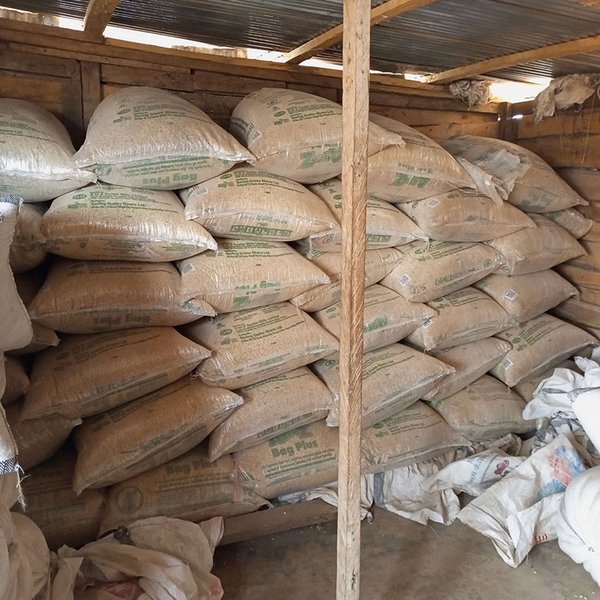
The transparent hermetic bags allow buyers to see which cereal is inside.
How do you ensure this?
Mittmann: In collaboration with Humboldt-Universität Berlin and a Fraunhofer Institute, we developed sensors detecting fermentation and insect damage. They can be read out with a free app that would alert the user to a quality problem. What is really exciting is that because any buyer has an incentive to read out the sensors, you can establish the route the bag has taken. This is interesting in terms of quality management, but also, and increasingly, with a view to supply chain requirements on social sustainability, the Lieferkettengesetz – the new German legislation on supply chains–, or the requirements of shareholders and other stakeholders.
So you could guarantee traceability …
Mittmann: Yes, and more. The food industry suffers from unstructured and often unpredictable supply in terms of quantity and quality. For instance, a brewery in Ghana might often not know if it will be able to fill its vats with local grain at a reasonable price in the coming three months. If not, it will have to order a cargo ship from Ukraine or the Gulf of Mexico. By using bag data we could provide market information or act as intermediary and enable the industry to plan its supply chain better.
Speaking of quality, you mentioned aflatoxins earlier on.
Mittmann: Aflatoxin is the key quality criterion for the food industry. This applies in particular to breweries or the Nestlés of the world, and it has been the focus for regulators. Kenya is the leader in this respect, introducing and monitoring quite strict aflatoxin limits. While this is a positive development, it introduces uncertainty, both for the suppliers, who don’t know if their goods could be turned down, and for the industry, which is not sure whether it can rely on planned consignments. Rejecting consignments won’t cause a food company costs directly, but it could run out of raw material.
Here too, we are working on a solution that relies on traceability. While aflatoxin is infamous for high variability, this is not random. Aflatoxin occurs in certain locations, depends on the weather, on the post-harvest treatment and so on. So we believe that we can predict aflatoxin. This would be very valuable for the food industry, for public health and for agricultural interventions.
How would you predict aflatoxins?
Mittmann: A lot is unknown about which factors drive aflatoxin in a smallholder context. Aflatoxin testing is expensive, and its high variability means it is prone to sampling errors. This is what makes it so tricky. However, there is a wealth of data. The food industry already has to perform aflatoxin tests. We are working with industry to make this data usable through machine learning. Our aim is to develop an aflatoxin warning system with which we can spatially and temporally forecast the aflatoxin risk. This would allow forecasting safe zones for each season as well as zones with high risk.
But for the farmers concerned, this would mean no longer being able to supply …
Mittmann: Yes, for the time being. But there are ways to reduce aflatoxin contents, for example via decontamination with ozone or low-temperature plasma. With the aid of the warning system, one could target where such measures make economic sense – basically where aflatoxin is high. Of course, it is much more sensible to tackle aflatoxin where it arises. There are solutions for soil treatment, such as the biocontrol technology Aflasafe, with which the aspergillus moulds are gradually ousted by other moulds. But naturally, it is very difficult to convince farmers to make such an investment over several years, especially if nobody cares whether their grain contains aflatoxin and treatment doesn’t provide them any added value. Even so, if we could apply such interventions in a targeted way, this would also be a big step for food losses and public health.
How confident are you that such a system can establish itself?
Mittmann: We design systems to solve problems for the industry, which ultimately bears the cost. And these are the businesses of the food industry at the end of the grain value chain. This is the seat of power, this is where the money is, and this is where the decisions are taken. It is important to exactly understand their processes. How is quality management performed, how is it recorded? Are batches tracked? What are the costs when consignments have to be rejected? How often are aflatoxin limits exceeded in intermediary or final products? We need to demonstrate how much money is lost and how our solution makes economic sense. Henning Vogt, our CTO, is running the development and is confident that the costs for the sensors will be just a few cents, and the corresponding IT will be very cheap at significant volumes. This makes such a system so attractive, considering the value created in avoided food losses, quality, traceability and aflatoxin management.
One requirement for hermetic storage is dry grain. Is this something that the farmers can basically handle well?
Mittmann: This depends very much on the climate zone and, of course, also on the price. In the West of Kenya, for instance, depending on the altitude, harvesting is done between August and October, when dry weather conditions prevail. But there are also many countries and regions in Africa where drying is a huge problem. For example, in Ghana’s middle belt, harvesting takes place right in the middle of the rainy season. At this time, farmers can no longer dry the grain on a tarpaulin in the sun. Here, dryers are the normal solution, but they aren’t usually available. And drying is expensive. Again, farmers have to work out if they can find a buyer for wet grain or if they can make more money selling dry grain. Here, the respective capacities have to be created – and this is a volume game requiring a lot of capacity, which means it needs to be an economically viable venture for the farmer and the drying business.
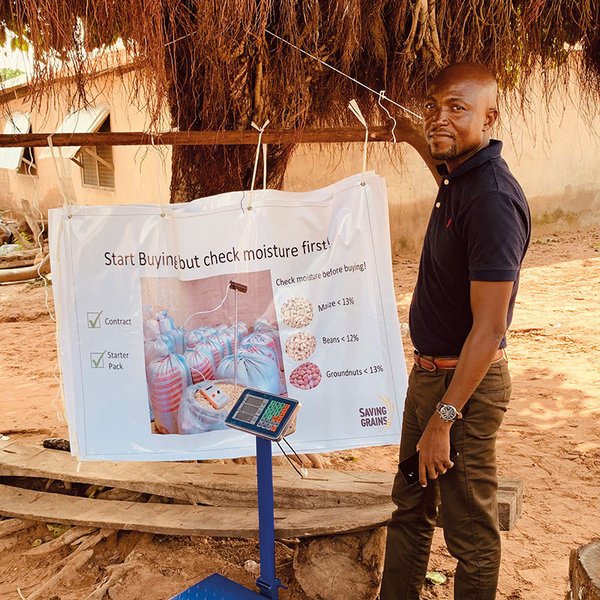
A village demonstration of the Saving Grains App.
Is that also part of your concept?
Mittmann: We have a commercial dryer available. But most dryers are diesel-, charcoal or gas-powered, so they aren’t environmentally friendly. This is why we are collaborating in a pilot project with the agricultural engineering department of Kwame Nkrumah University of Science and Technology in Ghana and the Fund for the Promotion of Innovation in Agriculture, i4Ag. With this cooperation, we are looking at biomass dryers in order to find out if we can operate these dryers ecologically and economically, and if this is also worthwhile from a material cycle angle. We want to see if enough biomass is available when cultivating maize. Do the cobs and the entire plant provide enough energy? Is there enough other biomass around without cutting down trees?
When can the first results be expected?
Mittmann: The dryer should be ready for the harvest season in Ghana next year. We would then operate it alongside a diesel-driven dryer to compare capacities. Of course, many other factors have to be considered, such as transportation costs of grain to the dryer and labour costs.
Does it makes sense to get the governments on board in your ventures?
Mittmann: We see only little support. With tight budgets, perhaps quite rightly, it is more tempting for governments to invest in high-value products. Exports to help their country’s economy are more important than supporting a small company with big ideas. So far, we have seen little potential for cooperation. Maybe that will change once we have reached a certain size.
And what about other partners?
Mittmann: Just like any other start-up, we are looking for investments. This applies in particular to Africa and to start-ups which are still in the seed phase. We have been working with a grant from the Accelerator of the World Food Programme and the Austrian Development Agency and are grateful to Bayer’s corporate giving. The “Deutsche Bundesstiftung Umwelt” supported our technology development. Now we have entered a larger partnership with Deutsche Gesellschaft für Internationale Zusammenarbeit and its i4Ag for three years until August 2026. As a social business, we seek to achieve impact, but we cannot, for example, run farmer trainings at a large scale or develop a lot of infrastructure in the villages. This is where we meet our limits. In this partnership, we benefit from GIZ infrastructure and advance our scale and corporate goals. So, this is a mutually beneficial partnership and a big opportunity for us.
What can a social business do better than conventional development cooperation?
Mittmann: It is natural for development cooperation organisations to have political goals and processes, all of which make sense in the given context. Their nightmare is taxpayer’s money being embezzled, and they build their processes accordingly. But these organisations don’t work along free market lines. We have a company’s orientation on profit, which keeps costs lean, and are at the same time guided by social aspects, where the impact I am having is clearly measured. And whereas one dollar in development cooperation can only amount to one dollar, a dollar invested in a social business can generate ten, a hundred or even a thousand dollars in transfer performance, depending on how efficiently the business model spreads and how much investment is needed later on.
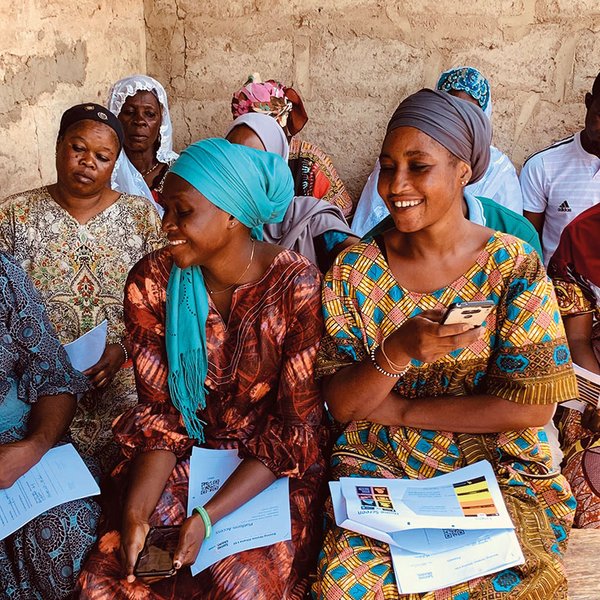
Onboarding of market women in the North of Ghana. Photos: Wolfgang Mittmann
Now this is a bird’s eye view, as no development agency we know of just gives money to build a business. It is always linked to specific targets and activities. But still, I think it explains the growing interest on the part of development cooperation to invest in innovative start-ups, social businesses, investment funds and the wider start-up ecosystem. It isn’t long until 2030. And we are nowhere near reaching the Sustainable Development Goals. This is why we are very happy to work with pioneers from i4Ag.
What would you like to see regarding international cooperation?
Mittmann: A structured political dialogue on what a new type of development cooperation should look like. We need to look at risk and the way we deal with failure. If we only rely on safe bets, we will miss out on big opportunities. Learn from venture capitalists. If they make seed investments they know most will go bust. A few will return their investments, but they make money from the one or two investments that scale a hundredfold. This is a difficult conversation to have – can we invest taxpayer’s money in risky ventures? What if they really do go bust? What if they change their business model? What if they actually succeed and make lots of money having been funded for free? For development cooperation, every project must be a success. But for all these successes, when I travel in rural Africa, I still see the hoe more often than the tractor. So, I believe this is the time to have a dialogue addressing all these issues.
What is important in a partnership between a social business and government development cooperation?
Mittmann: It is trust. Trust that you can work with each other and sort out problems. It is openness to work with a focal point that you can tell about the real challenges. It is the degree of freedom that you allow companies. If the development agency follows the logic of supporting a scaling business that creates impact, it is important that goals align. The development agency should demand results towards its goals. On the other hand, the development agency and its support may move the start-up further and further from its core business preventing the desired scaling. A balance has to be sought, and the development agency should be mindful of the power dynamics.
What is your long-term vision? Upscaling by private investors?
Mittmann: We are very proud of our growth so far, but we are still small. We focused on getting our model right, so it is profitable, impactful and scalable. Our third co-founder, Kelvin Tyron, is really the huge champion of this and has made dozens of changes. Our next milestone is solid market proof of our business model in Ghana and Kenya. We aim to reach 20,000 farmers. However, if we can show solid market proof for impact, for profits and for scalability, why can’t we leapfrog to a much higher scale? There are impact investors but also institutions, such as the International Finance Corporation or the World Bank, the IFAD and foundations like Rockefeller and Gates. Why wouldn’t they put big money behind a proven solution to one of the world’s problems? There are so many capable founders in Africa – we could set up businesses in five new countries through a franchising model. Or we could bring in corporate partners, like major grain traders or breweries, and scale through their footprint. Again, it boils down to proving profitability, impact and scalability. And we are not far off. Then, everything will be possible. Together, we can solve a big problem at scale!
The partnership
Saving Grains was founded in 2019 by Wolfgang Mittmann (CEO), Henning Vogt (CTO) and Kelvin Tyron (CPO/COO). The start-up has developed out of the World Food Programme Innovation Accelerator. Its social business model aims to allow farmers to benefit from future grain prices. The company recently started working with Deutsche Gesellschaft für Internationale Zusammenarbeit (GIZ) in the context of the project “Reducing post-harvest losses and utilising agricultural residues”. This project is commissioned by the German Federal Ministry for Economic Cooperation and Development (BMZ). It is part of the Fund for the Promotion of Innovation in Agriculture (i4Ag) and is carried out by Saving Grains on behalf of GIZ in Ghana and Kenya. Here, i4Ag seeks to increase the scale and impact of the solution. Specific aims include increasing female participation, offering training on wider post-harvest management and providing trading infrastructure to farming communities.
In November 2023, Saving Grains was awarded the German Entrepreneurship Award for Development.
Interview: Silvia Richter


